You go to war with the army you have, not the army you might want or wish to have at a later time.
Donald H. Rumsfeld, Dec. 14, 2006
Ben Jackel, stoneware and beeswax, 2008
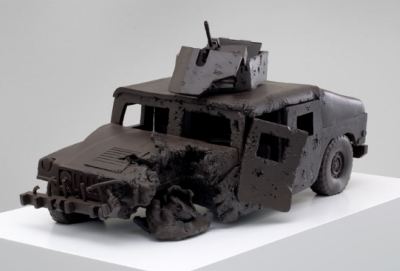
Regina Hackett takes her Art to Go
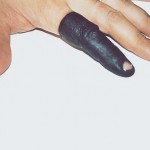
That old grade-school test question - Which of these does not belong? - offers a key to the aesthetics of the expressively hot, as opposed to the classically cool. The hint of crazy within the solid citizen, the blood in the water and the worm in the rose (mortal, guilty) move us in a way that visions of perfection rarely do. In honor of the flaw, a small survey of its recent, robust manifestations. Douglas Gordon Three Inches (Black) 1997 (image via) Susan Robb: Three from the last … [Read More...]
Filed Under: Uncategorized
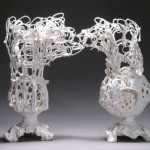
If human history were underwater, Alwyn O'Brien's ceramic vessels could serve as the bleached bones of the Ancien Regime, the decorative drained and dead on a dark sea floor. 4 Descending Notes 2010 Manganese Clay and Glaze 9" x 7" x 5 1/2" Hand-rolled coils make her lacy vessels. Born past their prime, they are in their own weird way pristine. Story of Looking, 2010 Porcelain and glaze, Two Pieces 12 1/2" x 14" x 5" Following Thelonious Monk, she knows how to use the wrong … [Read More...]
Filed Under: Uncategorized
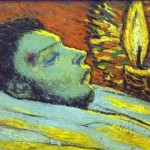
Collectors who hire experts to solve problems that don't exist till help arrives are responsible for the equivalent of bad face lifts on old masters. What the artists intended too frequently recedes under an abrasive cleaning or a deadening layer of varnish. Current practices discourage irreversible interventions. That means John Currin's work is a little safer than artists who preceded him, such as Picasso, although having the money to buy good advice doesn't guarantee it will be heeded. … [Read More...]
Filed Under: Uncategorized
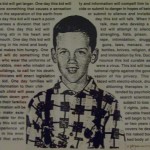
Nice to see David Wojnarowicz (wana-row-vitch) back in the news, making the monkeys dance. It's no surprise that the usual people want to use their deliberate misunderstanding of his work to rally their frightened base. It's also no surprise that the Smithsonian once again proves to be cowardly. Remember its Enola Gay exhibit from 1995? The examination of this country's use of the Atom Bomb started as scholarly and turned into a my-country-right-or-wrong cheering section, after suitable … [Read More...]
Filed Under: Uncategorized
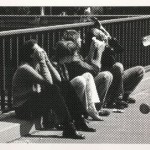
Humans see, humans do: After the first horse drawn on the first cave and the first pot incised with a decorative line, everything became imitation. You don't need a weatherman to know which way that wind blows, or that in the contemporary period, it blows harder. In selecting the 12 artists featured in Image Transfer: Pictures in a Remix Culture, associate Henry curator Sara Krajewski looked for those whose engagements with image recycling make them visual mix masters of note, those who … [Read More...]
Filed Under: Uncategorized
By Regina Hackett Leave a Comment
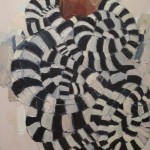
Mequitta Ahuja Wriggle, oil on canvas, 41"X26" 2008. Could have been titled, Medusa takes a nap. Geoffrey Chadsey Welterweight, 2002 Watercolor pencil on rag vellum, tape 57" x 24" Another great Chadsey figure with flowing locks. (Not safe for work.) Lauren Grossman Behold 2003 Iron, wool, steel. 13"x21"x12" Rolls on casters. Mequitta Ahuja, again. Flowback, oil on canvas, 68"X51" 2008 … [Read More...]
Filed Under: Uncategorized
You go to war with the army you have, not the army you might want or wish to have at a later time.
Donald H. Rumsfeld, Dec. 14, 2006
Ben Jackel, stoneware and beeswax, 2008

Seattle’s Dawn Cerny, as part of the exhibit at 4Culture. Her flags revel in local resentments, defunct businesses and crackpots.
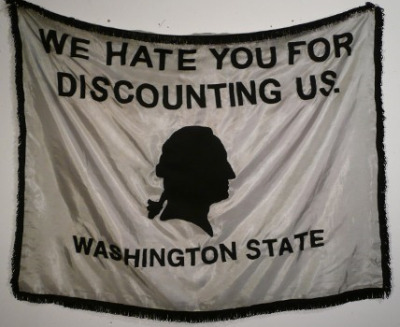

 Jack Daws is into home craft. Below, he pickles old glory.
Jack Daws is into home craft. Below, he pickles old glory.
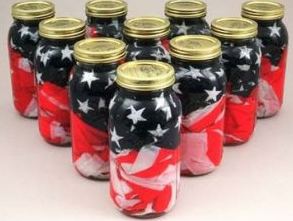 Costa Vece – from the coffin of lost causes.
Costa Vece – from the coffin of lost causes.
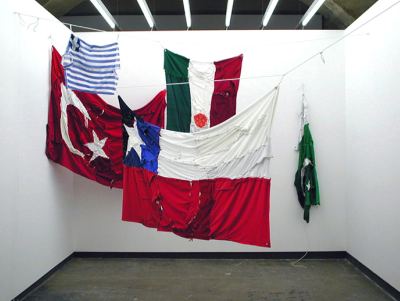 Harmon de Hoop– red, white and blue product under a red, white and blue grid.
Harmon de Hoop– red, white and blue product under a red, white and blue grid.
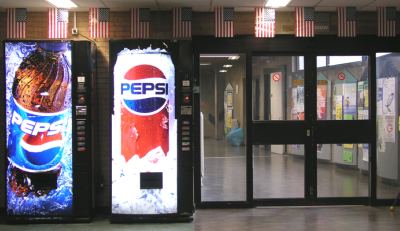 Ed Templeton – American Pride for Sale. Looks like a good thing to me.
Ed Templeton – American Pride for Sale. Looks like a good thing to me.
Spiegelman’s St. Louis Refugee Ship Blues is stellar. Nobody treads in the dark with as light a touch. Example, his final frame:
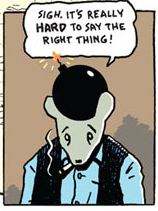 He’s referring to what Danish Prime Minister Anders Fogh Rasmussen called his country’s worst international crisis since World War II, here. In Seattle, only the Stranger ran the cartoons in question.
He’s referring to what Danish Prime Minister Anders Fogh Rasmussen called his country’s worst international crisis since World War II, here. In Seattle, only the Stranger ran the cartoons in question.
To this post – In a dry season, what blooms out the back end? – Eric Fredericksen added the essential Naomi Fisher. Thanks, Eric!
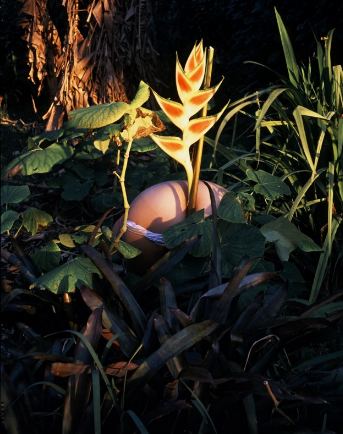
At the press preview for the Seattle Art Museum’s small but choice Wyeth exhibit, Remembrance, exhibit curator Patricia Junker said Wyeth was the figure whom the international crew of artists featured in Michael Darling’s Target Practice: Painting Under Attack (1949-78) had in mind.
Both exhibits open tomorrow. (Target Practice reviews to follow.)
Wyeth’s admirers try to insinuate him into the thick of things. For the artists in Target Practice, however, he wasn’t on the firing range. Rauschenberg erased a de Kooning. Andrew Wyeth? His name did not come up.
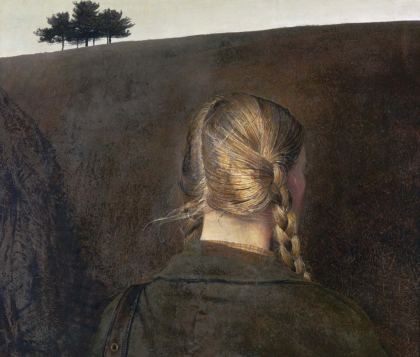 Wyeth backed himself into a corner of a particular place rooted in land and family and painted his fear of the world. With a desperate and dry exactitude, he documented every inch of what mattered to him. He aimed for sentimentality but didn’t get there.
Wyeth backed himself into a corner of a particular place rooted in land and family and painted his fear of the world. With a desperate and dry exactitude, he documented every inch of what mattered to him. He aimed for sentimentality but didn’t get there.
His idea of the beautiful is dead-on-arrival, but his depiction is the equivalent of Miss Havisham preserving her cake.
Take Farm Road, above. (1979, Tempera on masonite, 21 inches high by 25 1/4 inches wide. Private collection.) Rembrandt-light shines on the greasy hair of his model, gray and brown at its roots and brass in its braids. Is the farm road in the title the rigid path of her hair? There is no other.
The rusted iron ground that rises in front of her blocks her progress. She’s right where he wants her, under his surveil, every hair on her head counted. Above, where she isn’t looking, the flat light of another dull day rises against a horizon line broken by a cluster of trees.
Wyeth is the American version of Edvard Munch, literal where Munch is flowing but tapping into the same emotional territory. Wyeth’s scream is that there is no scream. He’s the painter of a vast suppression, what it took for him to pass for normal in the countryside.
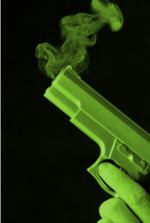 Death does not have to hang heavy in your head for you to be a fan of Obit. (I’m a fan, and I’m singing a happy tune as I type this. Worms crawl in, worms crawl out...)
Death does not have to hang heavy in your head for you to be a fan of Obit. (I’m a fan, and I’m singing a happy tune as I type this. Worms crawl in, worms crawl out...)
Fellow AJ blogger, Jeff Weinstein, contributes to the site, most recently with a fine piece titled Hidden Memorials, on ephemeral Sufi shrines in the desert.
All that is by way of saying Obit’s Top 10 List of Stupid Death Tricks is not just anybody’s death-trick list.
Number 3, for example:
A prop can still be a deadly weapon.
Actors on Hollywood sets are routinely warned to be careful with guns used as props, but in 1984, Jon-Erik Hexum, a star of the CBS action series Cover-Up, pretended to play Russian roulette by putting a blank-loaded .44 Magnum to his temple. “Let’s see if this will do it,” he reportedly said, and pulled the trigger. The burst of hot gas fired at close range penetrated his skull.
I’d like to read a top ten list of stupid death tricks that didn’t work. Chris Burden in his reckless youth would loom large on it, when he attempted to electrocute himself, and had himself shot, nailed to a VW bug and stuffed into a sack left in traffic. The trick here, in the format of a top 10 list, would be to convey to an undifferentiated audience why everything he did continues to matter so much, to not make a joke out of some of art’s most soulful moments.
Who’s the link, lifeline, thread and thing to be scorned? He opened the door for the grandiose and unruly, for those whose hearts have (Pascal’s phrase) reasons that reason cannot know. The artists below are among many in his debt.
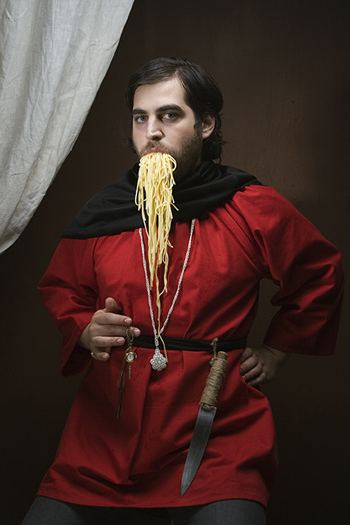 Titus Kaphar
Titus Kaphar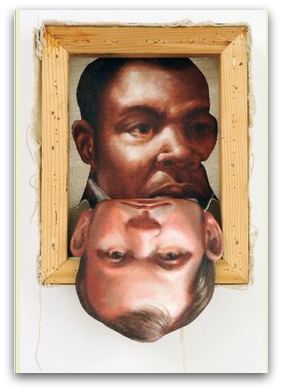 Dan Webb (Hold)
Dan Webb (Hold)
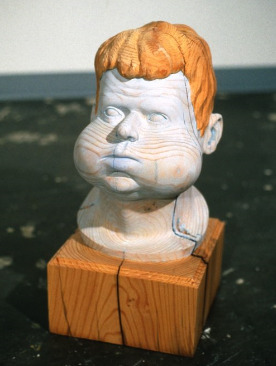 Mike Simi (Self-Portrait)
Mike Simi (Self-Portrait)
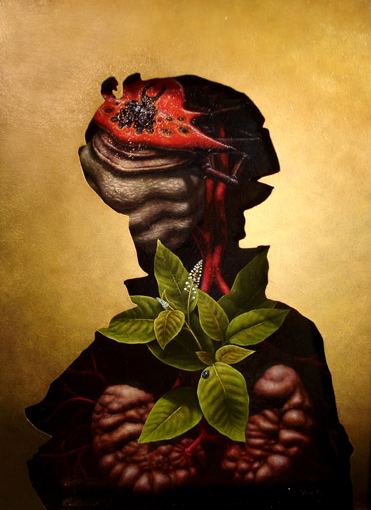 The answer is, of course, Mr. Elaborately Ceremonial.
The answer is, of course, Mr. Elaborately Ceremonial.

an ArtsJournal blog


